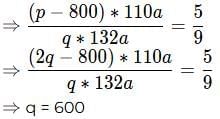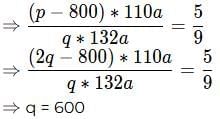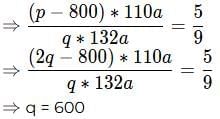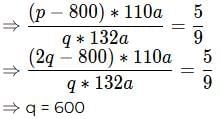Practice Question - 59 (Quant Based) | 100 DILR Questions for CAT Preparation PDF Download
The base exchange rate of a currency X with respect to a currency Y is the number of units of currency Y which is equivalent in value to one unit of currency X. Currency exchange outlets buy currency at buying exchange rates that are lower than base exchange rates, and sell currency at selling exchange rates that are higher than base exchange rates.
A currency exchange outlet uses the local currency L to buy and sell three international currencies A, B, and C, but does not exchange one international currency directly with another. The base exchange rates of A, B and C with respect to L are in the ratio 100 : 120 : 1. The buying exchange rates of each of A, B, and C with respect to L are 5% below the corresponding base exchange rates, and their selling exchange rates are 10% above their corresponding base exchange rates. The following facts are known about the outlet on a particular day:
- The amount of L used by the outlet to buy C equals the amount of L it received by selling C.
- The amounts of L used by the outlet to buy A and B are in the ratio 5 : 3.
- The amounts of L the outlet received from the sales of A and B are in the ratio 5 : 9.
- The outlet received 88000 units of L by selling A during the day.
- The outlet started the day with some amount of L, 2500 units of A, 4800 units of B, and 48000 units of C.
- The outlet ended the day with some amount of L, 3300 units of A, 4800 units of B, and 51000 units of C.
Q1: How many units of currency A did the outlet buy on that day?
 View Answer
View Answer 
Ans: 1200
It is given that the base exchange rates of A, B and C with respect to L are in the ratio 100 : 120 : 1. Let us assume that base exchange rates are '100a', '120a' and 'a' in that order.
It is given that the buying exchange rates of each of A, B, and C with respect to L are 5% below the corresponding base exchange rates. Therefore, we can say that the buying exchange rates are 95a, 114a, 0.95a.
It is given that the selling exchange rates of each of A, B, and C with respect to L are 10% above their corresponding base exchange rates. Therefore, we can say that the selling exchange rates are 110a, 132a, 1.1a.
We know about the opening and closing units in stock for each currency. Let us draw the table accordingly.  Let 'p', 'q' and 'r' be the number of units of currency A, B and C bought by the outlet on that day.
Let 'p', 'q' and 'r' be the number of units of currency A, B and C bought by the outlet on that day.
Then, we can say that the outlet sold 'p - 800', 'q' and 'r - 3000' units of currency A, B and C respectively.  It is given that the amount of L used by the outlet to buy C equals the amount of L it received by selling C.
It is given that the amount of L used by the outlet to buy C equals the amount of L it received by selling C.
⇒ 0.95a * r = 1.1a * (r - 3000)
⇒ 0.15r = 3300
⇒ r = 22000
It is also given that the amounts of L used by the outlet to buy A and B are in the ratio 5:3.
Also, the amounts of L the outlet received from the sales of A and B are in the ratio 5:9.

Therefore, p = 2q = 2 * 600 = 1200.
It is given that the outlet received 88000 units of L by selling A during the day.
⇒ (p-800) * 110a = 88000
⇒ (1200-800) * 110a = 88000
⇒ 44000a = 88000
⇒ a = 2
We can fill the entire table and answer all the questions. From the table we can see that the currency outlet bought 1200 units of A.
From the table we can see that the currency outlet bought 1200 units of A.
Q2: How many units of currency C did the outlet sell on that day?
(a) 22000
(b) 19000
(c) 6000
(d) 3000
 View Answer
View Answer 
Ans: (b)
It is given that the base exchange rates of A, B and C with respect to L are in the ratio 100:120:1. Let us assume that base exchange rates are '100a', '120a' and 'a' in that order.
It is given that the buying exchange rates of each of A, B, and C with respect to L are 5% below the corresponding base exchange rates. Therefore, we can say that the buying exchange rates are 95a, 114a, 0.95a.
It is given that the selling exchange rates of each of A, B, and C with respect to L are 10% above their corresponding base exchange rates. Therefore, we can say that the selling exchange rates are 110a, 132a, 1.1a.
We know about the opening and closing units in stock for each currency. Let us draw the table accordingly.  Let 'p', 'q' and 'r' be the number of units of currency A, B and C bought by the outlet on that day.
Let 'p', 'q' and 'r' be the number of units of currency A, B and C bought by the outlet on that day.
Then, we can say that the outlet sold 'p - 800', 'q' and 'r-3000' units of currency A, B and C respectively.  It is given that the amount of L used by the outlet to buy C equals the amount of L it received by selling C.
It is given that the amount of L used by the outlet to buy C equals the amount of L it received by selling C.
⇒ 0.95a * r = 1.1a * (r - 3000)
⇒ 0.15r = 3300
⇒ r = 22000
It is also given that the amounts of L used by the outlet to buy A and B are in the ratio 5:3.
Also, the amounts of L the outlet received from the sales of A and B are in the ratio 5:9.

Therefore, p = 2q = 2 * 600 = 1200.
It is given that the outlet received 88000 units of L by selling A during the day.
⇒ (p-800) * 110a = 88000
⇒ (1200-800) * 110a = 88000
⇒ 44000a = 88000
⇒ a = 2
We can fill the entire table and answer all the questions. From the table we can see that the currency outlet sold 19000 units of currency C. Hence, option B is the correct answer.
From the table we can see that the currency outlet sold 19000 units of currency C. Hence, option B is the correct answer.
Q3: What was the base exchange rate of currency B with respect to currency L on that day ?
 View Answer
View Answer 
Ans: 240
It is given that the base exchange rates of A, B and C with respect to L are in the ratio 100:120:1. Let us assume that base exchange rates are '100a', '120a' and 'a' in that order.
It is given that the buying exchange rates of each of A, B, and C with respect to L are 5% below the corresponding base exchange rates. Therefore, we can say that the buying exchange rates are 95a, 114a, 0.95a.
It is given that the selling exchange rates of each of A, B, and C with respect to L are 10% above their corresponding base exchange rates. Therefore, we can say that the selling exchange rates are 110a, 132a, 1.1a.
We know about the opening and closing units in stock for each currency. Let us draw the table accordingly.  Let 'p', 'q' and 'r' be the number of units of currency A, B and C bought by the outlet on that day.
Let 'p', 'q' and 'r' be the number of units of currency A, B and C bought by the outlet on that day.
Then, we can say that the outlet sold 'p - 800', 'q' and 'r-3000' units of currency A, B and C respectively.  It is given that the amount of L used by the outlet to buy C equals the amount of L it received by selling C.
It is given that the amount of L used by the outlet to buy C equals the amount of L it received by selling C.
⇒ 0.95a * r = 1.1a * (r - 3000)
⇒ 0.15r = 3300
⇒ r = 22000
It is also given that the amounts of L used by the outlet to buy A and B are in the ratio 5:3.
Also, the amounts of L the outlet received from the sales of A and B are in the ratio 5:9.

Therefore, p = 2q = 2 * 600 = 1200.
It is given that the outlet received 88000 units of L by selling A during the day.
⇒ (p-800) * 110a = 88000
⇒ (1200-800) * 110a = 88000
⇒ 44000a = 88000
⇒ a = 2
We can fill the entire table and answer all the questions. From the table we can see that the base exchange rate of currency B with respect to currency L was 240.
From the table we can see that the base exchange rate of currency B with respect to currency L was 240.
Q4: What was the buying exchange rate of currency C with respect to currency L on that day?
(a) 1.10
(b) 0.95
(c) 2.20
(d) 1.90
 View Answer
View Answer 
Ans: (d)
It is given that the base exchange rates of A, B and C with respect to L are in the ratio 100:120:1. Let us assume that base exchange rates are '100a', '120a' and 'a' in that order.
It is given that the buying exchange rates of each of A, B, and C with respect to L are 5% below the corresponding base exchange rates. Therefore, we can say that the buying exchange rates are 95a, 114a, 0.95a.
It is given that the selling exchange rates of each of A, B, and C with respect to L are 10% above their corresponding base exchange rates. Therefore, we can say that the selling exchange rates are 110a, 132a, 1.1a.
We know about the opening and closing units in stock for each currency. Let us draw the table accordingly.  Let 'p', 'q' and 'r' be the number of units of currency A, B and C bought by the outlet on that day.
Let 'p', 'q' and 'r' be the number of units of currency A, B and C bought by the outlet on that day.
Then, we can say that the outlet sold 'p - 800', 'q' and 'r - 3000' units of currency A, B and C respectively.  It is given that the amount of L used by the outlet to buy C equals the amount of L it received by selling C.
It is given that the amount of L used by the outlet to buy C equals the amount of L it received by selling C.
⇒ 0.95a * r = 1.1a * (r - 3000)
⇒ 0.15r = 3300
⇒ r = 22000
It is also given that the amounts of L used by the outlet to buy A and B are in the ratio 5:3.
Also, the amounts of L the outlet received from the sales of A and B are in the ratio 5:9.

Therefore, p = 2q = 2 * 600 = 1200.
It is given that the outlet received 88000 units of L by selling A during the day.
⇒ (p-800) * 110a = 88000
⇒ (1200-800) * 110a = 88000
⇒ 44000a = 88000
⇒ a = 2
We can fill the entire table and answer all the questions. From the table we can see that the buying exchange rate of currency C with respect to currency L was 1.9. Hence, we can say that option D is the correct answer.
From the table we can see that the buying exchange rate of currency C with respect to currency L was 1.9. Hence, we can say that option D is the correct answer.
|
102 videos|123 docs|121 tests
|
FAQs on Practice Question - 59 (Quant Based) - 100 DILR Questions for CAT Preparation
| 1. What is the CAT exam and what is its purpose? |  |
| 2. What are the key sections in the CAT exam? |  |
| 3. How is the CAT exam scored? |  |
| 4. What are some effective strategies for preparing for the CAT exam? |  |
| 5. What are the eligibility criteria for taking the CAT exam? |  |















